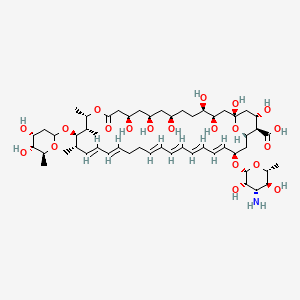Nystatin A3
Nystatin A3 is a lipid of Polyketides (PK) class. Nystatin a3 is associated with abnormalities such as Mycoses, Candidiasis of the genitals and Gigantism. The involved functions are known as Drug Interactions, Process, Synthesis, Fermentation and Anabolism. Nystatin a3 often locates in Cell membrane, Membrane, Protoplasm, Entire oral cavity and integral to membrane. The associated genes with Nystatin A3 are Gene Clusters. The related lipids are Sterols, 1,2-oleoylphosphatidylcholine, Membrane Lipids, DOPE and N-caproylsphingosine.
Cross Reference
Introduction
To understand associated biological information of Nystatin A3, we collected biological information of abnormalities, associated pathways, cellular/molecular locations, biological functions, related genes/proteins, lipids and common seen animal/experimental models with organized paragraphs from literatures.
What diseases are associated with Nystatin A3?
Nystatin A3 is suspected in Mycoses, Candidiasis of the genitals, Gigantism and other diseases in descending order of the highest number of associated sentences.
Related references are mostly published in these journals:
| Disease | Cross reference | Weighted score | Related literature |
|---|
Possible diseases from mapped MeSH terms on references
We collected disease MeSH terms mapped to the references associated with Nystatin A3
PubChem Associated disorders and diseases
What pathways are associated with Nystatin A3
There are no associated biomedical information in the current reference collection.
PubChem Biomolecular Interactions and Pathways
Link to PubChem Biomolecular Interactions and PathwaysWhat cellular locations are associated with Nystatin A3?
Visualization in cellular structure
Associated locations are in red color. Not associated locations are in black.
Related references are published most in these journals:
| Location | Cross reference | Weighted score | Related literatures |
|---|
What functions are associated with Nystatin A3?
Related references are published most in these journals:
| Function | Cross reference | Weighted score | Related literatures |
|---|
What lipids are associated with Nystatin A3?
Related references are published most in these journals:
| Lipid concept | Cross reference | Weighted score | Related literatures |
|---|
What genes are associated with Nystatin A3?
Related references are published most in these journals:
| Gene | Cross reference | Weighted score | Related literatures |
|---|
What common seen animal models are associated with Nystatin A3?
There are no associated biomedical information in the current reference collection.
NCBI Entrez Crosslinks
All references with Nystatin A3
Download all related citations| Authors | Title | Published | Journal | PubMed Link |
|---|---|---|---|---|
| Gruenwald H et al. | Philadelphia chromosome in eosinophilic leukemia. | 1965 | Am. J. Med. | pmid:5853474 |
| Ainley R and Smith B | Fungal flora of the conjunctival sac in healthy and diseased eyes. | 1965 | Br J Ophthalmol | pmid:5840426 |
| Orbach EJ | Candida albicans, a contributing cause of torpid vascular ulcers of the lower extremities. | 1965 | Angiology | pmid:5844138 |
| Kinsky SC et al. | Interaction of polyene antibiotics with subcellular membrane systems. I. Mitochondria. | 1965 | Mol. Pharmacol. | pmid:5294438 |
| HAMER P and PETERSEN A | [FARMER'S LUNG]. | 1965 | Dtsch. Med. Wochenschr. | pmid:14242202 |
| WILLIAMS ST and DAVIES FL | USE OF ANTIBIOTICS FOR SELECTIVE ISOLATION AND ENUMERATION OF ACTINOMYCETES IN SOIL. | 1965 | J. Gen. Microbiol. | pmid:14287203 |
| MITCHELL JC | DRUGS FOR SUPERFICIAL FUNGOUS INFECTIONS OF THE SKIN. | 1965 | Can Med Assoc J | pmid:14339306 |
| LANDAU JW et al. | THE RAPID FORMATION IN SERUM OF FILAMENTS BY CANDIDA ALBICANS. | 1965 | J. Invest. Dermatol. | pmid:14275693 |
| ROSE AH and EVISON LM | STUDIES ON THE BIOCHEMICAL BASIS OF THE MINIMUM TEMPERATURES FOR GROWTH OF CERTAIN PSYCHROPHILIC AND MESOPHILIC MICRO-ORGANISMS. | 1965 | J. Gen. Microbiol. | pmid:14283028 |
| HORA JF | PRIMARY ASPERGILLOSIS OF THE PARANASAL SINUSES AND ASSOCIATED AREAS. | 1965 | Laryngoscope | pmid:14312647 |
| SHELLEY WB | ERYTHEMA ANNULARE CENTRIFUGUM DUE TO CANDIDA ALBICANS. | 1965 | Br. J. Dermatol. | pmid:14314422 |
| LICHTENSTEIN NS and LEAF A | EFFECT OF AMPHOTERICIN B ON THE PERMEABILITY OF THE TOAD BLADDER. | 1965 | J. Clin. Invest. | pmid:14322038 |
| COHN I | INTESTINAL ANTISEPSIS. | 1965 Jan-Feb | Dis. Colon Rectum | pmid:14254999 |
| Mostafa MS | Aspergillus niger infection of the eye. | 1966 | Am. J. Ophthalmol. | pmid:5957897 |
| Kahn SG and Slocum A | Water miscible amphotericin for the treatment of crop mycosis in chicks. | 1966 | Poult. Sci. | pmid:5967855 |
| Kantor HI et al. | Treatment trends in monilial vaginitis. | 1966 | South. Med. J. | pmid:5933151 |
| Tio TH et al. | Subcutaneous phycomycosis. | 1966 | Arch Dermatol | pmid:5940919 |
| Stritzler C | Cutaneous candidiasis treated with topical amphotericin B. A comparative study. | 1966 | Arch Dermatol | pmid:5900690 |
| Catterall RD | Candida albicans and the contraceptive pill. | 1966 | Lancet | pmid:4162170 |
| Ernest JT and Rippon JW | Keratitis due to Allescheria boydii (Monosporium apiospermum). | 1966 | Am. J. Ophthalmol. | pmid:5334519 |
